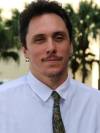 Sean Perry earned his Ph.D. in Mathematical Sciences from Florida Atlantic University in Fall 2022. Learn about his path to graduate school, his experience at Florida Atlantic, and what Sean has been up to after graduating.
Sean Perry earned his Ph.D. in Mathematical Sciences from Florida Atlantic University in Fall 2022. Learn about his path to graduate school, his experience at Florida Atlantic, and what Sean has been up to after graduating.
After earning a Bachelor of Science degree from FAU, I taught at Jupiter High School for one semester before deciding to head back to graduate school. However, after the near-death of a close friend whose life was saved thanks to some incredible EMTs, I enrolled in EMT basic, then Fire Academy, and then I became a paramedic. I worked as a medic for several years, but I decided that I needed a higher level of skill as a medical professional. I began working on my medical school prerequisites at Indian River State College where I met Daniel Kind, who was at that time a mathematics graduate student at FAU. I decided to finish what I had started at FAU 8 years earlier.
I sat in on some upper-level undergraduate courses to review (Dr. Klingler's Modern Algebra and Dr. Yuan's Analysis), and I was surprised by how much clearer everything seemed. I also sat in on Dr. Lock's graduate Graph Theory course. I took up a problem he posed on super edge graceful graphs, and together, we published my first paper that year. I had attained a discipline and a work ethic in my thirties that I did not possess in my early twenties.
I have always been fascinated by patterns, from simple and abstract ones. I eventually learned that to study some of my favorites - waves and the movement of gasses, light and the dance that it does - I would need to study some fairly sophisticated math.
I devoted myself to starlight, namely studying mathematical facets of the image counting problem from gravitational microlensing.
Drs. Terje Hoime was the first person to do an independent study with me. She taught me Topology I and II as an undergrad, and topology eventually became one of my primary mathematical interests. Drs. Klingler, Yuan, Locke, Magliveras, Lundberg, Naudot, Schonbek and Motta all gave their energy and time to teach me. Drs. Schonbek and Motta also did independent studies with me. Dr. Schonbek taught me differential geometry, and Dr. Motta taught me the fundamentals of Machine Learning and Topological Data Analysis. I also worked as a GRA under Dr. William Kalies, where I learned much about dynamical systems and coding numerical experiments.
I was an officer in the local branches of SIAM and AMS and presented at seven conferences and two virtual conferences. I also was privileged to participate in an AMS sponsored Mathematics Research Community, “On Gravity and Light,” organized by Drs. Arlie Petters, Marcus Werner, and Charles Keeton. I applied on the suggestion of my advisor, Dr. Lundberg. There, I was exposed to the material that would become the focus of my dissertation.
I have a postdoc position at USF that I am looking forward to. After that, I may stay in academia. I have learned not to get too terribly hung up making plans. Life, as they say, is what happens when you're busy making those. Better to focus on the moment. I have research to attend to and students who need me. My garden is thriving and the surf is up. Life is good.